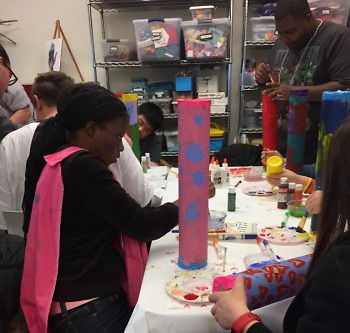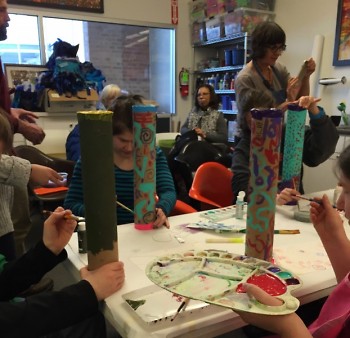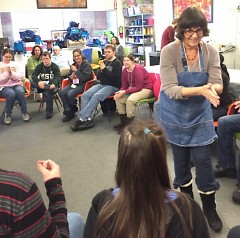Everything is moving quickly. There are only three people here—an artist, the program director, and an intern—but they are scattering to put everything in place. Paint, smocks, brushes, markers, pallets, paper, and more are spread out evenly across a dozen seats, taking careful consideration so everything goes smoothly.
It’s an early Wednesday morning, and ACT is busy preparing for an Arts & Mentoring class that will come at 9:30. Arts & Mentoring is a six-week adult arts program through which students set goals for learning and developing and achieve those goals through art. This Arts & Mentoring class is “Music Around the World,” where students experience music, dance, and create their own art pieces around music.
Today, the students are designing their rain sticks, a multi-week kinetic instrument project they have been working on. This particular class period is to help students gain concentration, because they have to carefully plan their design and stay focused for the two-hour class time to complete the project.
Students begin to trickle in, and immediately there is electricity in the air. By the time all students arrive, the teaching artist puts music on, the students strike up conversations with each other and workers, and everyone is smiling. There is a deep connection between everybody, and everybody is happy to be here.
“I love this class. I love these students,” shared Kat VanHammen, the teaching artist of this particular Arts & Mentoring group. “They are very creative and engaged.”
Even as a bystander, it is clear how personal and engaged the class is. After Kat gives instructions on sketching a design first, students dive in and find their own rhythm. Teaching artists and other workers sit down with the students and talk through their art with them, empowering the artists to take creative liberty and validating their ideas, giving the students the confidence to start painting.
This is, perhaps, the most important impact of the class—it leaves creativity to the students. One student paints hearts. Another does an intricate geometric design. Another covers her rain stick in roses. One student even carefully has red paint dripping from the top, because he wanted to make it scary. In the end, the students created completely unique and personal artwork. The combinations they used of color, designs, paintbrush size, and even style all relate to how the student feels—their personalities, their likes, dislikes, and the way they want to express themselves.
“I didn’t know what to expect,” shared Jeff VanderBerge, a long-time volunteer and former member of the board of directors. Despite his experience as a volunteer, this was Jeff’s first meeting with this particular class and these specific students. “The students showed a lot of individuality and creativity.”
As if this class has not engaged students’ creativity, individuality, and growth already, this Arts & Mentoring class does more.
After the projects are complete and drying, the students gather in a semi-circle for one final activity of the day. This particular class is one focused on visual art, but with a movement arts component as well. Today, the students are ending their class by playing a game in which the program director uses an instrument that creates water-like sounds and the students use their imagination to match the sounds with various motions.
It is an exercise that pulls students outside of their comfort zones and makes them make connections between auditory sounds and their imaginations. One student who has been quiet all day steps forward and does an amazingly-accurate rendition of diving, beaming with confidence as the entire group cheers. Once again, the project has successfully built students’ confidence while also building important skills and connections, all through the arts.
At the end of the class, the teaching artist validates the students’ work by saying, “I’m really proud of you. You stayed focused and did some amazing work.” Students leave reluctantly, still smiling, looking forward to next week. Meanwhile, ACT begins clean-up, already preparing for the next incredible program.
Written by Annabelle Miller, Writing and PR Intern
The Rapidian, a program of the 501(c)3 nonprofit Community Media Center, relies on the community’s support to help cover the cost of training reporters and publishing content.
We need your help.
If each of our readers and content creators who values this community platform help support its creation and maintenance, The Rapidian can continue to educate and facilitate a conversation around issues for years to come.
Please support The Rapidian and make a contribution today.


